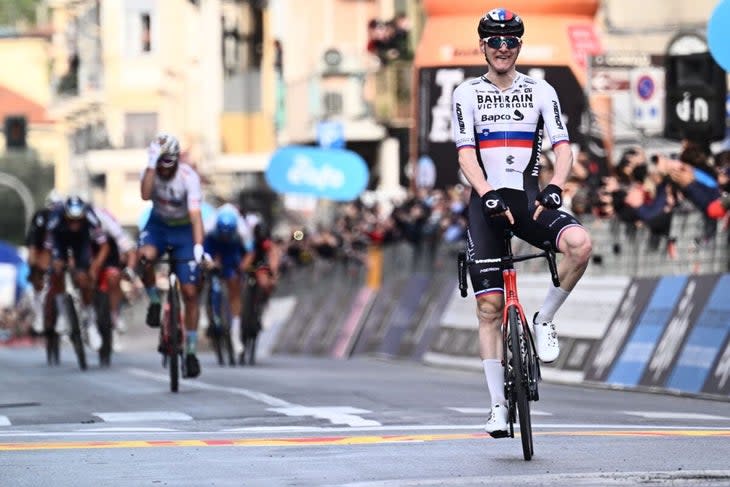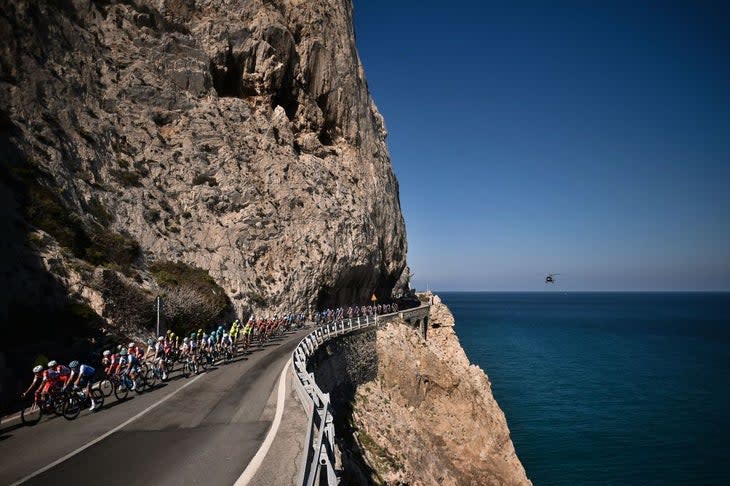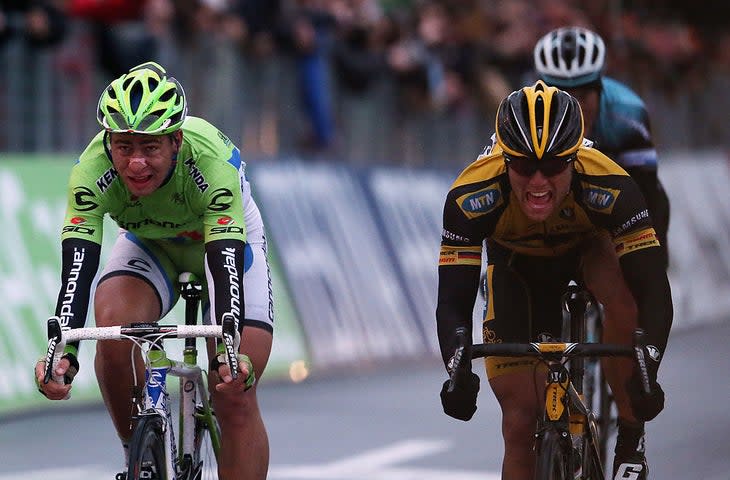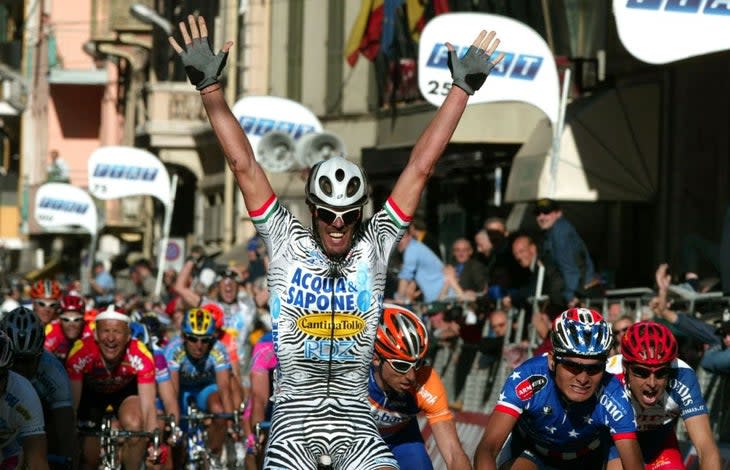Milan-San Remo preview: Favorites, course details, and who will rule the Poggio
- Oops!Something went wrong.Please try again later.
This article originally appeared on Velo News
114th Milan-San Remo
Date: Saturday, March 18, 2023
Start: Abbiategrasso
Finish: San Remo
Distance: 294km
2022 winner: Matej Mohoric (Bahrain-Victorious)
Milan-San Remo opens monument season Saturday in what’s the easiest race to finish, but the hardest to win.
All eyes will be on Tadej Pogacar to see if he can fend off the sprinters and drop his rivals on the always decisive stampede up the Poggio.
Of cycling’s five revered monuments, Italy’s La Primavera is a race that’s many things at once. It’s the longest race on the elite men’s calendar, but technically and vertically one of the least challenging.
San Remo is also one of the oldest races on the calendar, yet there’s no tried and true winning formula. Every year is a different scenario.
What was once a “sprinter’s race” is now a free-for-all that’s open from monument brawlers to skinny climbers, to TT monsters to the scrawny all-rounders.
Milano-Sanremo, as it’s known to the purists, is at once gloomily boring and wildly exuberant.
What to expect Saturday?
Hard to pick one favorite

There’s no one favorite for San Remo.
Rather, La Primavera is often a race of scenarios. And over the past two decades, the race has definitely turned away from its sprinter’s roots toward a more pure power/bravado blueprint.
Sprinters like Caleb Ewan say it’s almost impossible to match the watt surges over the top of the Poggio from classics beasts like Wout van Aert and Mathieu van der Poel.
The race unfolds based on where the action happens. The early break can go deep at San Remo, but no way will it make it to the line to contest for the spoils. Weather and wind (see below) can also play a huge role on how the finish plays out.
Here are a few ways to unravel the San Remo Rubic’s cube:
Scenario One: Long-distance attack from the Cipressa
The last attack from here to stick to the Via Roma was Gabriele Colombo in 1996. In today’s highly wound peloton, it’s hard to imagine any rider or even a committed attack of a few riders of having the legs to fend off the collective mass of the peloton. Lately, there’s been hype that Van der Poel or Pogacar could do it, but so far, it hasn’t happened. The chances are slim, say five percent.
Scenario Two: Attack up the Poggio
It wasn’t so long ago that the most powerful riders could stretch out and distance the bunch on the upper reaches of the Poggio, and carry a gap over the top. Again, that’s becoming rarer as the overall power and depth of the peloton ramps up. It will be single-file in the final kilometer of the Poggio, and even when a crack develops, others come over the top to close it down. Still, riders like Alaphilippe and Van Aert pack the punch to open a significant and decisive gap to the others before the the top, and then carry that to the line. Let’s put this at 20 percent.
Scenario Three: Attack over the Poggio
This is a slight twist on the above, but it’s the one that’s most likely to play out Saturday. The strongest riders are at the front on the power drive up the Poggio, the group fractures in the wake of the intense acceleration, and a gap opens in the opening switchbacks on the top of the descent. A small group emerges to battle it out for the spoils at the line. Riders can often peel off these groups to solo home to win by a whisker. There’s a 50-50 chance this will replay Saturday.
💜 Milano-Sanremo presented by @CA_Ita 💜
2019 🏆 @alafpolak1
2020🏆 @WoutvanAert
2021🏆@Jasperstuyven
2022🏆 @matmohoric2023 ❓ #MilanoSanremo pic.twitter.com/7ygtiZdxPO
-- Milano Sanremo (@Milano_Sanremo) March 14, 2023
Scenario Four: Descending attack down the Poggio
This is how Matej Mohoric won in a spectacular fashion in 2022. Using a dropper post, the Slovenian flew over the top of the Poggio and immediately went on the offensive on the descent. By the opening string of switchbacks, he opened up a winning margin of a few seconds that he could nurse to the line in one of the most daring and spectacular victories in San Remo history. Chances of it happening again? 15 percent.
Scenario Five: Reduced bunch sprint
There’s still plenty of asphalt for the leanest and most explosive sprinters to chase back for a reduced bunch sprint. All eyes are on riders like Arnaud De Lie or Biniam Girmay to make it to the line Saturday. As Tom Pidcock said, teammates don’t really count in the closing 10km of San Remo, so it’s every rider for themselves. Bunch sprints are growing rare at San Remo, so put it at 15 percent. Unfortunately, the Ineos rider won’t be in action this weekend after picking up a concussion in a crash at Tirreno-Adriatico.
What’s a 100-percent guarantee is that no one knows what will happen in the closing 10km.
A new start for the traditional course

There are a few very minor tweaks for 2023. The most significant is that the race starts in Abbiategrasso, which at about 20km outside of the city center. That’s not quite Milan, but hey, Paris-Roubaix doesn’t start in Paris, so no one’s counting.
At 294km, it’s the longest race on the elite men’s calendar. For most of its nearly seven hours of racing, San Remo follows a familiar tried-and-true pattern.
The opening two hours are across the flats of the Po Valley, and that’s where the day’s main breakaway will form. Sometimes these breakaways can include a relatively large number of riders and open up gaps topping 20 minutes.
The Passo del Turchino topping at 588m in the northern edge of the Apennines is the day’s highest point and often close to its midway point. There is a definitive before and after the race hits the Mediterranean Coast.
The speed ramps up and the chase is on along the Italian Riviera. A series of headlands called the “capi” along the Ligurian Coast are open to the wind and the pressure starts to pile on.
The famed Cipressa, added in 1982, is 5.6km at 4.1 percent. That’s steep enough to spit anyone off their best out the back. In fact, many helpers and riders on a bad day will peel off when the race descends back to the coast road and pedal straight back to the team bus at the finish line.
Then comes the Poggio and endless scenarios start to play out.
Weather: Spring has sprung
Forecasters are calling for east to west winds of 15 to 20kph blowing down the Italian Riviera. That means tailwinds and a very fast race that could open up the action to some longer-distance attacks.
Springlike temperatures should hold into the weekend, with cold to welcome the peloton for the early start in northern Italy, and a bright spring sun waiting for the bunch when it hits the coast.
If the wind forecast holds, it could set up the peloton for some fliers to try their luck on the Cipressa. No one’s won from there in decades, and even with a tailwind, it would be hard for anyone to fend off the entire peloton.
Tailwinds going up the Poggio will only heighten the tension and pressure to attack over the top.
How to watch: Live streaming
Live TV coverage begins on Saturday at 09h45 CET on Eurosport 2 and will beam the race in real time until the estimated finish at 16h50 CET.
There’s live streaming on GCN+ and discovery+.
Who’s won, and who’s never

Former winners starting the 114th edition include Mark Cavendish, who won his lone San Remo all the way back in 2009 in a thrilling sprint against Heinrich Haussler.
John Degenkolb (2015), Arnaud Demare (2016), Michel Kwiatkowski (2017), Julian Alaphilippe (2018), Van Aert (2020), Jasper Stuyven (2021), and defending champion Mohoric are back.
Some big names who’ve yet to win who might have been expected to? Twice second, Peter Sagan is back for his 13th and final San Remo. Also twice second is Caleb Ewan, who will be co-leader with rising star Arnaud De Lie.
Americans, young and old

Three Americans are racing, with Larry Warbasse (Ag2r-Citroen), Kevin Vermaercke (Team DSM), and Neilson Powless (EF Education-EasyPost) expected to race.
No American has ever won Milan-San Remo, but Greg LeMond and Fred Rodriguez were second, in 1986 and 2002, respectively.
Italy brings the most with 19 starters, while Austria, Eritrea, Hungary, Ireland, New Zealand, Slovakia, and Switzerland all see one starter each.
The oldest in the race? Total Energies’ Maciej Bodnar at 38. There are two 21-year-olds with Andrea Piccolo (EF Education-EasyPost) and Arnaud De Lie (Lotto Dstny), and one 20-year-old in Pavel Bittner (Team DSM), the youngest in the field.
Who we’re picking
Picking winners for San Remo is all but impossible, but you can narrow it down by scenario.
Long-range attack over the Cipressa? If anyone can do it, it’s Pogacar. Downhill attack a la Mohoric? Tom Pidcock, too bad he’s not racing. An elite group over the top to fend off the sprinters? Think Alaphilippe, Van Aert, and Van der Poel. A sprinter who packs the watts to stay with the accelerations? Biniam Girmay. A winner from the heart? Sagan.
For exclusive access to all of our fitness, gear, adventure, and travel stories, plus discounts on trips, events, and gear, sign up for Outside+ today.

